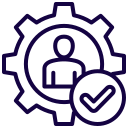Course Content
What’s at Stake and What is ISO/IEC 27001:2022?
What Is Information Security?
ISO 27000 Family of Standards
ISO 27001 Standard Structure
Principles of Auditing
Managing an audit programme
Conducting an audit
1. Initiating an Audit
2. Preparing audit activities
3. Conducting Audit Activities
Overview of Clause 4 : Context of the Organization
Clause 4.4 Information Security Management System
Clause 4 Quiz
Overview of Clause 5 : Leadership
Clause 5.1 Leadership and Commitment
Clause 5.2 Policy
Clause 5.3 Organizational roles, responsibilities and authorities
Clause 5 Quiz
Overview of Clause 6 : Planning
Clause 6.1.1 General requirements
Clause 6.1.2 Information Security Risk Assessment
Clause 6.1.3 Information security risk treatment
Clause 6.2 Information security objectives and planning to achieve them
Clause 6.3 Planning of changes
Clause 6 Quiz
Overview of Clause 7 : Support
Clause 7.1 Resources
Clause 7.2 Competence
Clause 7.3 Awareness
Clause 7.4 Communication
Clause 7.5.1 Documented information
Clause 7.5.2 Creating and Updating
Clause 7.5.3 Control of Documented Information
Clause 7 Quiz
Overview of Clause 8 : Operation
Clause 8.3 Information Security Risk Treatment
Clause 8 Quiz
Overview of Clause 9 : Performance evaluation
Clause 9.1 Monitoring, measurement, analysis and evaluation
Clause 9.2.1 General Requirements
Clause 9.2.2 Internal audit Programme
Clause 9.3.1 Management review: General Requirements
Clause 9.3.2 Management review Inputs
Clause 9.3.3 Management review results
Clause 9 Quiz
Clause 10.1 Continual improvement
Clause 10.2 Nonconformity and corrective action
Clause 10 Quiz
5.2 Information security roles and responsibilities
5.3 Segregation of duties
5.4 Management responsibilities
5.5 Contact with authorities
5.6 Contact with special interest groups
5.7 Threat intelligence
5.8 Information security in project management
5.9 Inventory of information and other associated assets
5.10 Acceptable use of information and other associated
5.11 Return of assets
5.12 Classification of information
5.13 Labelling of information
5.14 Information Transfer
5.15 Access control
5.16 Identity management
5.17 Authentication information
5.18 Access rights
5.19 Information security in supplier relationships
5.20 Addressing information security within supplier agreements
5.21 Managing information security in the ICT supply chain
5.22 Monitoring, review and change management of supplier services
5.23 Information security for use of cloud services
5.24 Information security incident management planning and preparation
5.25 Assessment and decision on information security events
5.26 Response to information security incidents
5.27 Learning from information security incidents
5.28 Collection of evidence
5.29 Information security during disruption
5.30 ICT readiness for business continuity
5.31 Legal, statutory, regulatory and contractual requirements
5.32 Intellectual property rights
5.33 Protection of records
5.34 Privacy and protection of PII
5.35 Independent review of information security
5.36 Compliance with policies, rules and standards for information security
5.37 Documented operating procedures
6.1 Screening
6.2 Terms and conditions of employment
6.3 Information security awareness, education and training
6.4 Disciplinary process
6.5 Responsibilities after termination or change of employment
6.6 Confidentiality or nondisclosure agreements
6.7 Remote working
6.8 Information security event reporting
7.1 Physical security perimeters
7.2 Physical entry
7.3 Securing offices, rooms and facilities
7.4 Physical security monitoring
7.5 Protecting against physical and environmental threats
7.6 Working in secure areas
7.7 Clear desk and clear screen
7.8 Equipment siting and protection
7.9 Security of assets offpremises
7.10 Storage media
7.11 Supporting utilities
7.12 Cabling security
7.13 Equipment maintenance
7.14 Secure disposal or reuse of equipment
8.1 User endpoint devices
8.2 Privileged access rights
8.3 Information access restriction
8.4 Access to source code
8.5 Secure authentication
8.6 Capacity management
8.7 Protection against malware
8.8 Management of technical vulnerabilities
8.9 Configuration management
8.10 Information deletion
8.11 Data masking
8.12 Data leakage prevention
8.13 Information backup
8.14 Redundancy of information processing facilities
8.15 Logging
8.16 Monitoring activities
8.17 Clock synchronization
8.18 Use of privileged utility programs
8.19 Installation of software on operational systems
8.20 Networks security
8.21 Security of network services
8.22 Segregation of networks
8.23 Web filtering
8.24 Use of cryptography
8.25 Secure development life cycle
8.26 Application security requirements
8.27 Secure system architecture and engineering principles
8.28 Secure coding
8.29 Security testing in development and acceptance
8.30 Outsourced development
8.31 Separation of development, test and production environments
8.32 Change management
8.33 Test information
8.34 Protection of information systems during audit testing








